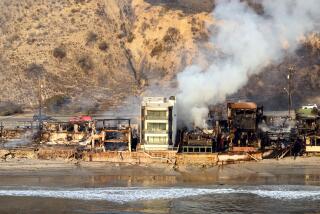Aftermath of Fire Disaster
- Share via
I have watched in disgust as Los Angeles has become increasingly polarized: blacks against Koreans, whites against Latinos--legal and illegal--and so on. The comments of Mike Davis (“Building Homes Amid a Landscape of Fire Ecology,” Opinion, Nov. 14) take this to new heights--the “flatlanders” against the hill dwellers.
Davis implies that the hills surrounding the greater L.A. area are filled with expensive homes and exclusive communities. He has been watching too much television. I would recommend a visit to the fire-damaged areas of the Santa Monica Mountains, where he will find the entire socioeconomic scale represented.
He goes on to lament the fact that “society as a whole must pay the huge costs of defending hillside developments from inevitable natural hazards.” Yes, Mr. Davis, that is what makes us a community versus independent, warring fiefdoms. Society as a whole pays when natural disasters such as earthquakes, floods, hurricanes, tornadoes and fires cause harm to the lives and property of members of that society. And society pays to protect members from man-made disasters such as pollution, crime and riots.
If Davis wants to live in a city of “flatlanders,” he might try Iowa. He had best choose a city away from any waterways. I don’t know what he will do about tornadoes.
TONI CRANE
Topanga
* Davis’ column proposes Draconian measures based upon confused facts. Urban-wild-land fire problems exist only in structures and communities built prior to 1985. Structural components, access and water systems have been developed for post-1985 construction that preclude the impact of catastrophic wildfires.
Davis is apparently the most confused regarding vegetation classed as “ornamental.” This biomass that is allowed to propagate around hillside homes takes on the same characteristics as wild-land fuels. Practically without exception, the recent home losses in Laguna, Malibu and Thousand Oaks were perpetuated by ornamental vegetation growing adjacent to structures. In 99% of the cases, this cultivated biomass was composed of non-native vegetation. These include junipers, conifers and eucalyptus with a sprinkling of acacia. Native California coastal live oaks proved the most fire resistive and in most cases acted as a fuel break around adjacent structures.
Studies by the Forest Service have shown that proper construction design and slope setbacks, coupled with landscaping composed of low-volume native shrubs, provide for a fire-safe environment. Davis is correct when he discusses prescribed burning. The western progression of the Altadena fire was checked by a prescribed burn conducted in 1987 above Millard Canyon. We can design fire-safe hillside communities utilizing vegetation management techniques with minimal impact (including visual) on the surrounding environment.
SCOTT E. FRANKLIN
Santa Clarita
* The people who live in hazardous areas are being subsidized by federal taxpayers through the Federal Emergency Management Agency. This subsidy has to cease. Anyone has empathy for those that suffer casualties, but this should not equate to a subsidy. As long as programs such as FEMA exist, those persons will continue to expect and receive these subsidies. The role of FEMA must be redefined to provide only temporary relief for disaster victims.
If people wish to live in flood plains, quake areas, brush areas, etc., they should carry adequate insurance for these hazards. As long as the federal government, meaning the taxpayer, continues to subsidize them, they will not be responsible for themselves.
DOUGLAS R. HARRISON
Escondido
More to Read
Sign up for Essential California
The most important California stories and recommendations in your inbox every morning.
You may occasionally receive promotional content from the Los Angeles Times.










